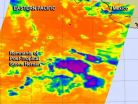(Press-News.org) BERKELEY — What if computer screens had glasses instead of the people staring at the monitors? That concept is not too far afield from technology being developed by computer and vision scientists at the University of California, Berkeley.
The researchers are developing computer algorithms to compensate for an individual's visual impairment, and creating vision-correcting displays that enable users to see text and images clearly without wearing eyeglasses or contact lenses. The technology could potentially help hundreds of millions of people who currently need corrective lenses to use their smartphones, tablets and computers. One common problem, for example, is presbyopia, a type of farsightedness in which the ability to focus on nearby objects is gradually diminished as the aging eyes' lenses lose elasticity.
More importantly, the displays could one day aid people with more complex visual problems, known as high order aberrations, which cannot be corrected by eyeglasses, said Brian Barsky, UC Berkeley professor of computer science and vision science, and affiliate professor of optometry.
"We now live in a world where displays are ubiquitous, and being able to interact with displays is taken for granted," said Barsky, who is leading this project. "People with higher order aberrations often have irregularities in the shape of the cornea, and this irregular shape makes it very difficult to have a contact lens that will fit. In some cases, this can be a barrier to holding certain jobs because many workers need to look at a screen as part of their work. This research could transform their lives, and I am passionate about that potential."
Using computation to correct vision
The UC Berkeley researchers teamed up with Gordon Wetzstein and Ramesh Raskar, colleagues at the Massachusetts Institute of Technology, to develop their latest prototype of a vision-correcting display. The setup adds a printed pinhole screen sandwiched between two layers of clear plastic to an iPod display to enhance image sharpness. The tiny pinholes are 75 micrometers each and spaced 390 micrometers apart.
The research team will present this computational light field display on Aug. 12 at the International Conference and Exhibition on Computer Graphics and Interactive Techniques, or SIGGRAPH, in Vancouver, Canada.
"The significance of this project is that, instead of relying on optics to correct your vision, we use computation," said lead author Fu-Chung Huang, who worked on this project as part of his computer science Ph.D. dissertation at UC Berkeley. "This is a very different class of correction, and it is non-intrusive."
The algorithm, which was developed at UC Berkeley, works by adjusting the intensity of each direction of light that emanates from a single pixel in an image based upon a user's specific visual impairment. In a process called deconvolution, the light passes through the pinhole array in such a way that the user will perceive a sharp image.
"Our technique distorts the image such that, when the intended user looks at the screen, the image will appear sharp to that particular viewer," said Barsky. "But if someone else were to look at the image, it would look bad."
In the experiment, the researchers displayed images that appeared blurred to a camera, which was set to simulate a person who is farsighted. When using the new prototype display, the blurred images appeared sharp through the camera lens.
This latest approach improves upon earlier versions of vision-correcting displays that resulted in low-contrast images. The new display combines light field display optics with novel algorithms.
Huang, now a software engineer at Microsoft Corp. in Seattle, noted that the research prototype could easily be developed into a thin screen protector, and that continued improvements in eye-tracking technology would make it easier for the displays to adapt to the position of the user's head position.
"In the future, we also hope to extend this application to multi-way correction on a shared display, so users with different visual problems can view the same screen and see a sharp image," said Huang.
INFORMATION:
The National Science Foundation helped support this work.
Vision-correcting display makes reading glasses so yesterday
2014-07-29
ELSE PRESS RELEASES FROM THIS DATE:
Researchers take steps toward development of a vaccine against tick-transmitted disease
2014-07-29
Virginia Commonwealth University School of Medicine researchers have made an important advancement toward developing a vaccine against the debilitating and potentially deadly tick-transmitted disease, human granulocytic anaplasmosis (HGA).
During the past several years, experts have seen a steady rise in the incidence of human infections caused by tick-transmitted bacterial pathogens — making the need for a vaccine critical. Successful vaccine development hinges on knowing what to target to prevent disease, and the VCU team has identified three such proteins on the surface ...
Brainwaves can predict audience reaction for television programming
2014-07-29
Media and marketing experts have long sought a reliable method of forecasting responses from the general population to future products and messages. According to a study conducted at the City College of New York (CCNY) in partnership with Georgia Tech, it appears that the brain responses of just a few individuals are a remarkably strong predictor.
By analyzing the brainwaves of 16 individuals as they watched mainstream television content, researchers were able to accurately predict the preferences of large TV audiences, up to 90 percent in the case of Super Bowl commercials. ...
Socialization relative strength in fragile X longitudinal study
2014-07-29
Standard scores measuring "adaptive behavior" in boys with fragile X syndrome tend to decline during childhood and adolescence, the largest longitudinal study of the inherited disorder to date has found.
Adaptive behavior covers a range of everyday social and practical skills, including communication, socialization, and completing tasks of daily living such as getting dressed. In this study, socialization emerged as a relative strength in boys with fragile X, in that it did not decline as much as the other two domains of adaptive behavior measured: communication and daily ...
Brand-specific television alcohol ads predict brand consumption among underage youth
2014-07-29
Underage drinkers are three times more likely to drink alcohol brands that advertise on television programs they watch compared to other alcohol brands, providing new and compelling evidence of a strong association between alcohol advertising and youth drinking behavior.
This is the conclusion of a new study from the Center on Alcohol Marketing and Youth (CAMY) at the Johns Hopkins Bloomberg School of Public Health and the Boston University School of Public Health that examined whether exposure to brand-specific alcohol advertising on 20 television shows popular with ...
$15 billion annual public funding system for doctor training needs overhaul, says IOM
2014-07-29
WASHINGTON -- The U.S. should significantly reform the federal system for financing physician training and residency programs to ensure that the public's $15 billion annual investment is producing the doctors that the nation needs, says a new report by the Institute of Medicine. Current financing -- provided largely through Medicare -- requires little accountability, allocates funds independent of workforce needs or educational outcomes, and offers insufficient opportunities to train physicians in the health care settings used by most Americans, the report says.
All ...
A new way to make microstructured surfaces
2014-07-29
A team of researchers has created a new way of manufacturing microstructured surfaces that have novel three-dimensional textures. These surfaces, made by self-assembly of carbon nanotubes, could exhibit a variety of useful properties — including controllable mechanical stiffness and strength, or the ability to repel water in a certain direction.
"We have demonstrated that mechanical forces can be used to direct nanostructures to form complex three-dimensional microstructures, and that we can independently control … the mechanical properties of the microstructures," says ...
NASA sees warmer cloud tops as Tropical Storm Hernan degenerates
2014-07-29
Tropical Storm Hernan degenerated into a remnant low pressure area on July 29. Infrared imagery from NASA's Aqua satellite revealed cloud tops were warming as the storm weakened.
The Atmospheric Infrared Sounder or AIRS instrument aboard Aqua gathered infrared data on a quickly weakening Hernan on July 29 at 5:11 a.m. EDT. The data was then made into a false-colored image at NASA's Jet Propulsion Laboratory in Pasadena, California. The AIRS image showed small, fragmented areas of a few powerful thunderstorms with high, cold cloud tops in Tropical Storm Hernan as it continued ...
Superconductivity could form at high temperatures in layered 2-D crystals
2014-07-29
An elusive state of matter called superconductivity could be realized in stacks of sheetlike crystals just a few atoms thick, a trio of physicists has determined.
Superconductivity, the flow of electrical current without resistance, is usually found in materials chilled to the most frigid temperatures, which is impractical for most applications. It's been observed at higher temperatures–higher being about 100 kelvin or minus 280 degrees below zero Fahrenheit–in copper oxide materials called cuprate superconductors. But those materials are brittle and unsuitable for fabricating ...
Autistic brain less flexible at taking on tasks, Stanford study shows
2014-07-29
The brains of children with autism are relatively inflexible at switching from rest to task performance, according to a new brain-imaging study from the Stanford University School of Medicine.
Instead of changing to accommodate a job, connectivity in key brain networks of autistic children looks similar to connectivity in the resting brain. And the greater this inflexibility, the more severe the child's manifestations of repetitive and restrictive behaviors that characterize autism, the study found.
The study, which will be published online July 29 in Cerebral Cortex, ...
Diet affects men's and women's gut microbes differently
2014-07-29
The microbes living in the guts of males and females react differently to diet, even when the diets are identical, according to a study by scientists from The University of Texas at Austin and six other institutions published this week in the journal Nature Communications. These results suggest that therapies designed to improve human health and treat diseases through nutrition might need to be tailored for each sex.
The researchers studied the gut microbes in two species of fish and in mice, and also conducted an in-depth analysis of data that other researchers collected ...


